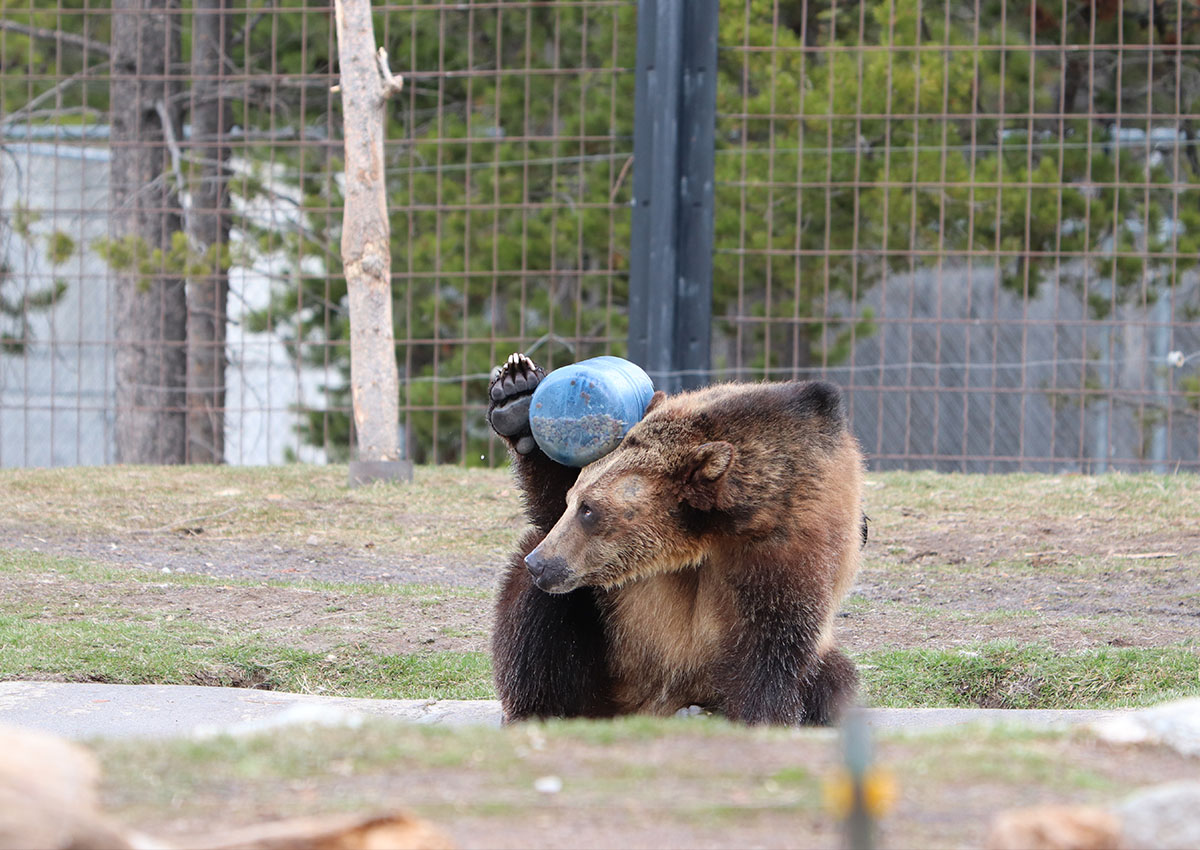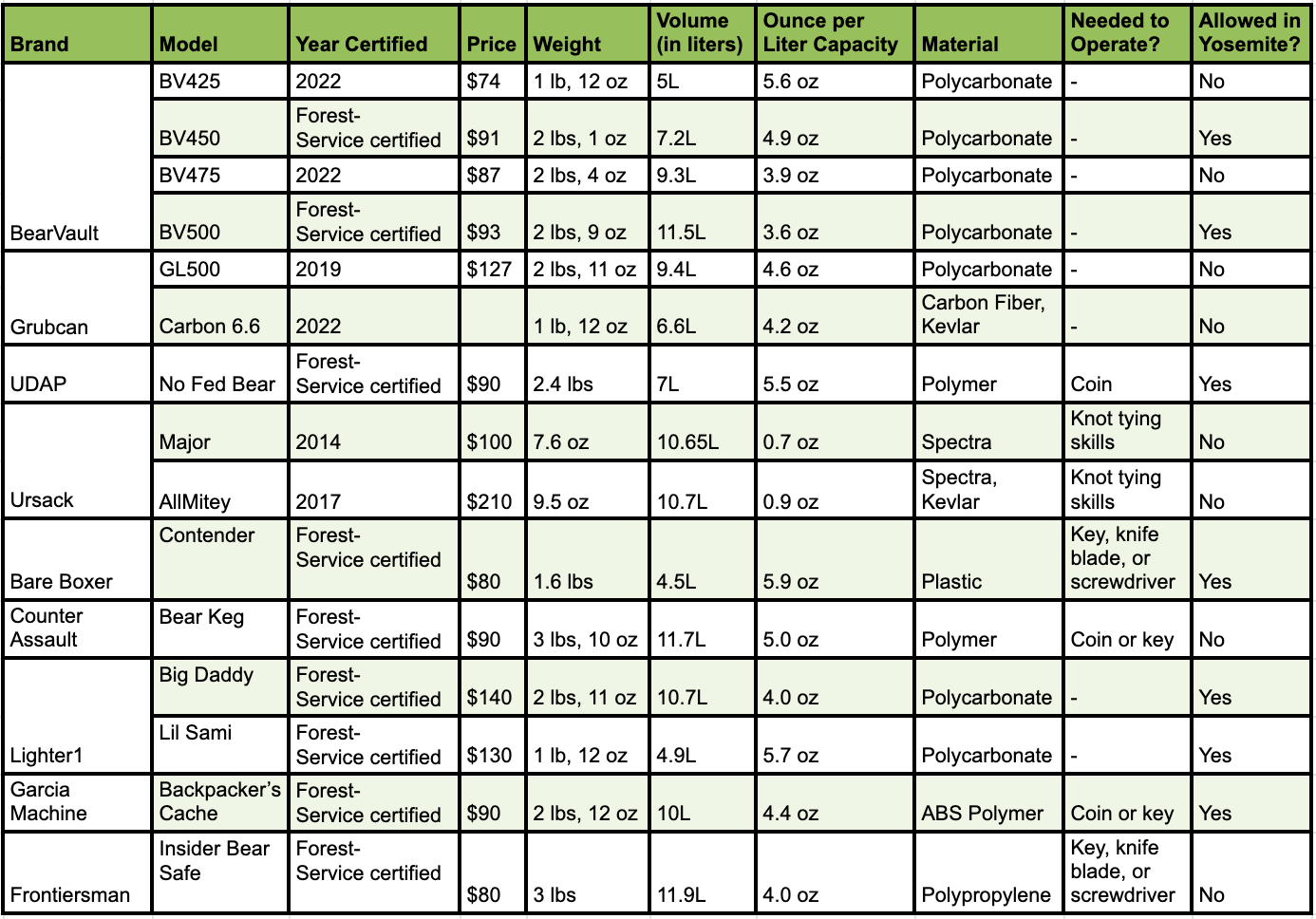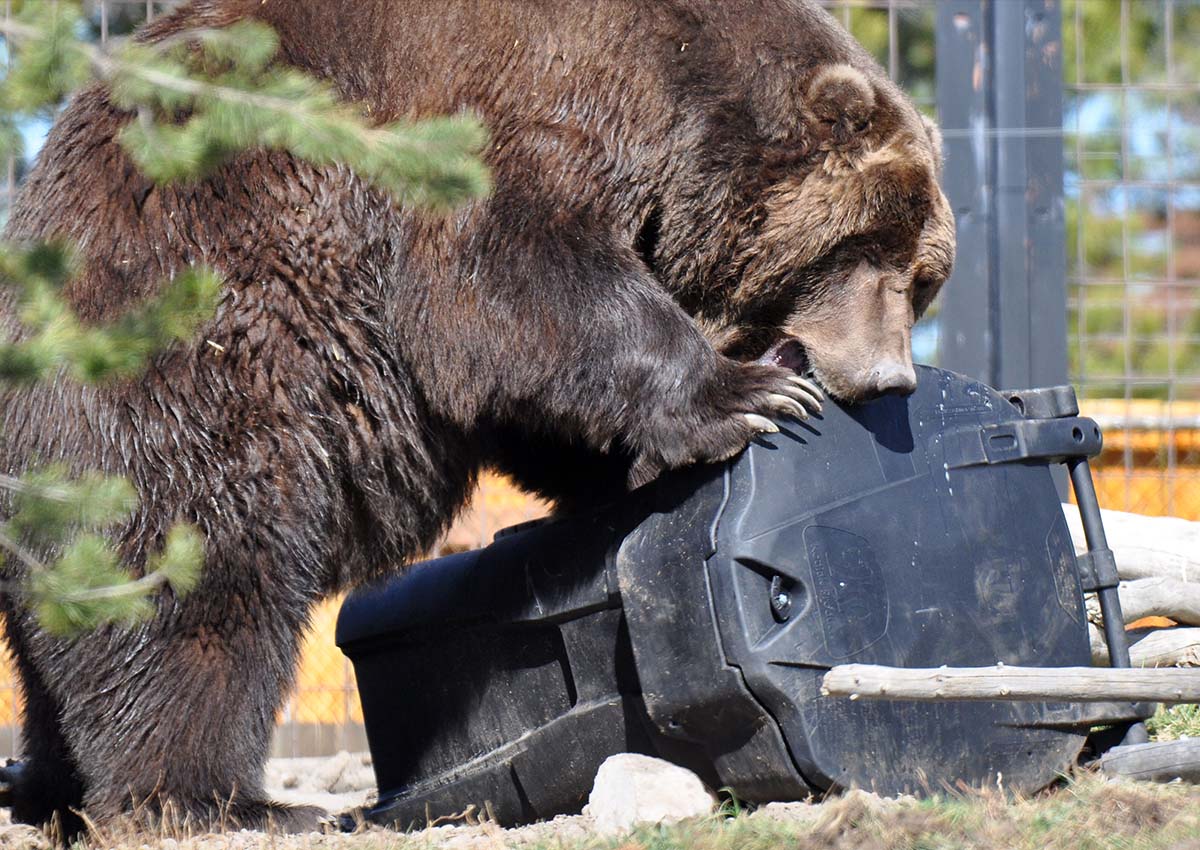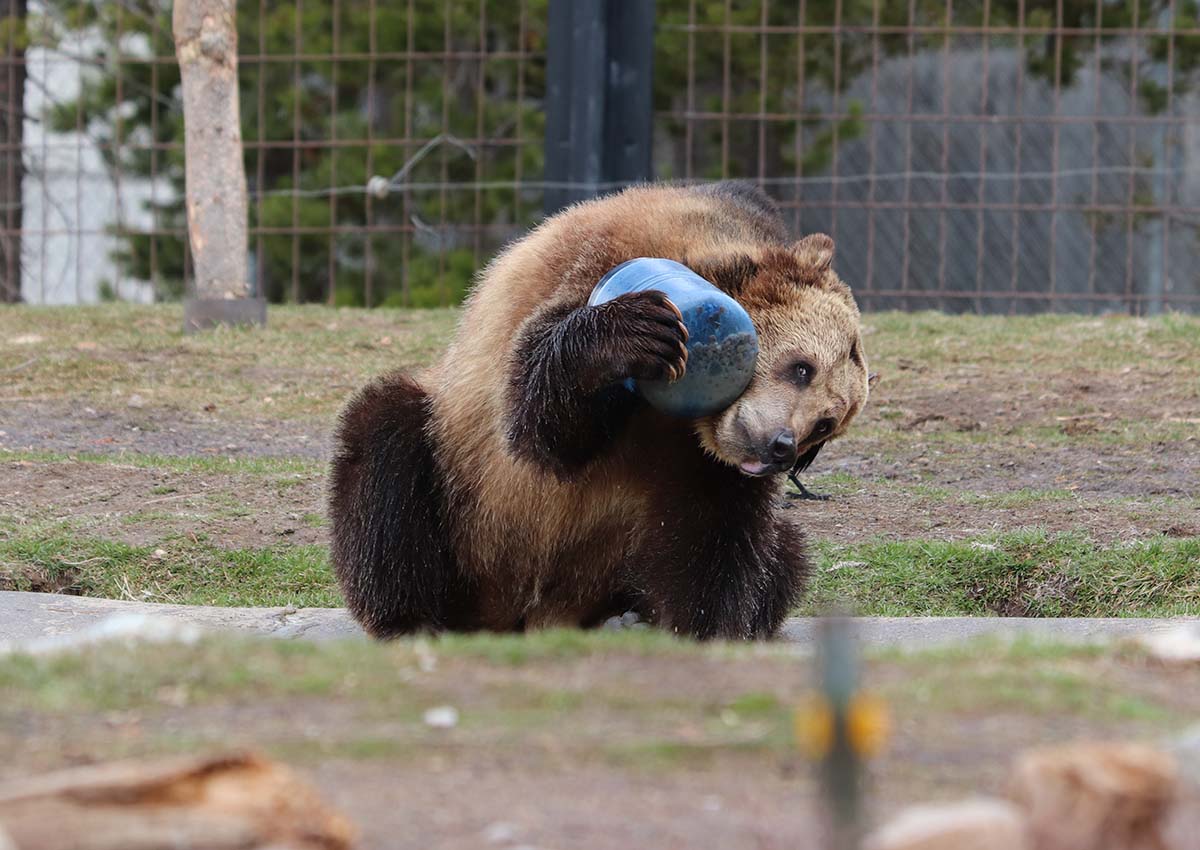A grizzly bear ripping open your food supply isn’t something most backpackers want to experience. That’s why bear canisters are made to withstand the most determined grizzlies and black bears. In fact, bear canisters are required by many popular backpacking destinations, like Yellowstone. The Grizzly & Wolf Discovery Center, located in West Yellowstone, tests and certifies bear cans for manufacturers. They don’t use calibrated machinery for the testing, either. They use live bears to test the best bear cans available.
One of the first things Randy Gravatt, the center’s container testing coordinator, will tell you is that the Center prefers the phrase “bear resistant” rather than “bear proof.”
“We don’t believe that anything out there is bear proof,” he says. “If you give a bear an unlimited amount of time, they will eventually get in pretty much everything.”
Gravatt would know. It’s his job to oversee grizzlies as they attempt crack open a variety of containers. For the last 18 years, bears at the center have been the tested trash cans, coolers, and bear cans. The center works in cooperation with the Interagency Grizzly Bear Committee, which certifies products as bear resistant.
Why They Use Bears for Testing

Before they partnered with the Grizzly & Wolf Discovery Center, the IGBC relied on more mechanical means to assess whether something was bear resistant or not. They would drop weights on products from a set height. They also used a penetrometer to measure how much force it took to penetrate the wall of a product. But when they switched to testing using live bears, they found that the number of passing products shrunk significantly.
“The pass rate when we first started testing was only about 10 percent,” says Gravatt. “Manufacturers had no idea how strong bears were, how food-driven they were, or how smart they were, and products were failing left and right.”
The pass rate began to increase over time—to as high as 60 or even 65 percent a few years ago—but has since dropped down to less than 50 percent. But with backpack canisters it’s even lower—around 30 percent.
“We have had canisters that failed in 15 seconds,” says Gravatt.
How a Grizzly Becomes a Tester
Some of the bears come to the center already well versed in how to break into containers. A bear named Spirit was relocated five times from Whitefish, Montana, because she kept getting at human food and was teaching her cubs to do the same. Then there’s four-year-old Bo, who was adept at foraging Yogi-Bear style near Yellowstone: from coolers, empty tents, and even a pickup truck. But that’s not the norm, says Gravatt.
“Almost all of our bears come to us when they are six, seven, eight months of age, when their mothers were killed or taken from them,” says Gravatt.
To help the grizzlies become top-notch container testers, Gravatt starts the training process when they are young—as early as six months old. First, the young cubs might find a cooler in their enclosure with food inside: fish, peanut butter, honey, tinned kippers. But instead of being firmly shut with a bear-resistant lock, the cooler will be held closed by a simple set of zip ties, with one corner left open. The bears quickly learn that a little effort yields a big reward.
“You do that once a week for two or three months, and before you know it that bear remembers all the food that they’re getting out of there.”
How Bears Test Bear Cans
A typical day at the Center starts at 8 a.m., with animal keepers going into the habitat to hide fruits and vegetables under rocks, stones, and branches. Once they’re finished, they open the doors for one of the bears to explore the habitat. Forty-five minutes later, by which point the bear has usually found all the food, a bell rings: that tells the bears that additional food is waiting for them back in their den. Once the first bear is secured, the animal keepers repeat the process for the rest of the bears.
But every so often, a bear discovers a locked bear can in the habitat while rooting around for hidden vegetables. That’s when the clock starts: The bear has one hour to breach the canister (or the canister has an hour to withstand the bear, depending on your perspective), before the bell rings. And while the bear might consider nothing less than a full belly a win for him (and true failure for the container), the IGBC standards are much stricter. A trash can with a hole an inch wide fails the test; for coolers and bear canisters, it’s a quarter-inch hole or larger.
“We’ve had bears stay out an hour or two hours longer than they were supposed to, because they were getting in,” says Gravatt, noting that the trained grizzlies would ignore their buzzer to return to their den.
Over time, the bears have developed a number of strategies for breaking into the containers. A bear will wedge a cooler or canister between rocks to create leverage. Or they might stand on a cooler, so that it will stay in place while they push against the lid. Sometimes the bear will use what Gravatt describes as a CPR maneuver: using both front paws to pulse up and down on the product in an effort to break it. (“You hear a crack, and game over.”)
Sometimes it’s possible to identify a problem with a new bear canister just by looking at it. If a bear can get its mouth around the bear canister, it’s more likely to be able to bite through or chew it. Longer canisters can also have problems, as they flex, which signals to the bears that it may be easier to break into.
“They are jumping up and down on that with their front paws,” he says. “When they feel that flex, they’re going to work that thing so much more.”
When companies call Gravatt to ask for his advice on making a new bear canister, he tells them the same thing: “Make something, and when you think it’s done, start all over again and make it twice as strong.”
Retesting Bear Cans
Until now, the Grizzly & Wolf Discovery Center hasn’t been retesting products, even those that were approved decades ago. But they are looking at changing that, due to concerns that materials may have changed over time. The center is currently considering a surprise retesting process of the products currently being sold to consumers. For now, Gravatt recommends that consumers purchase cans that were certified within the last five years. It’s also wise to replace older bear cans every five to seven years, since bear canisters can fail due to sun exposure or temperature fluctuations that degrade the integrity of the plastic.

Features They Don’t Test
Consumers should know that one criteria the IGBC does not consider is how easy a product is to use. For bear cans, there can be a wide range of skills or tools needed, from quick release knots to screwdrivers, while others are relatively simple to use. It’s important to read manufacturer instructions and practice using your bear canister at home prior to taking it out into the field.
The IGBC is beginning to monitor incidents where failures are attributable to users using products incorrectly, and it may remove products that consumers consistently use incorrectly.
Bear Canisters That Passed the Test
The Grizzly & Wolf Discovery Center tests anywhere between 60 and 80 products a year, and has tested more than 900 since they began working with the IGBC. Below is a list of the current bear canisters available on the market that the IGBC has approved.

Black Bears vs. Grizzlies

Despite the fact that black bears are far more common than grizzlies, there is not an approved list of bear canisters for use in black bear country—most agencies rely on the list approved by the IGBC. But generally, grizzlies are larger and stronger than black bears.
“That hump on [a grizzly’s] shoulder is all muscle and that goes down into their front arms,” he says. But many of the famous stories of bears breaching bear canisters in the wild are among black bears. In one notorious incident, an Adirondack bear called Yellow-Yellow learned how to open the locking mechanism of the popular BearVault (the manufacturer voluntarily changed its locking mechanism in response to this incident). Patti Sowka, director of the Living with Wildlife Foundation, says not to underestimate the problem-solving capabilities of grizzlies.
“We have seen the bears at the Grizzly and Wolf Discovery Center learn, and learn from each other by watching,” she said. “We had at least one bear who learned to unscrew things.”
The larger problem, says Sowka, is that some people who live in black bear country are choosing products that haven’t been tested by any bear, because they don’t feel they need something that can withstand the full might of a griz.
“A few people are even under the impression that bungee cords are good enough—just put a bungee cord over your garbage can—and, of course, that typically doesn’t work.”
But it wasn’t always this way. In the past, black bear canister testing was handled by the Sierra Interagency Black Bear Group, comprised of biologists and recreation and wilderness managers from Yosemite and Sequoia & Kings Canyon National Parks, as well as Inyo National Forest. Their process for testing black bear canisters differed slightly from that of the IGBC. While they also tested canisters with captive bears, using bears at the Folsom City Zoo Sanctuary, they also field-tested canisters. Bear canisters were given conditional approval, which allowed backpackers and other recreationists to use the canisters inside the parks while a biologist with the SIBBG conducted field tests in parallel for durability, functionality, and security. But that testing stopped when the agency disbanded in 2008. In 2021, the list of groups providing certification for bear-resistant products shrunk even further when WildSafeBC, which worked with the BC Wildlife Park in Kamloops, discontinued their testing program.
READ NEXT: The Newbie’s Guide to Survival in Bear Country
The Future of Bear Canister Testing

Patti Sowka recently took a new role as the captive black bear product testing coordinator for the Wildlife Management Institute, where she’ll be heading up a new initiative, in conjunction with the Southeastern Association of Fish and Wildlife Agencies, to test bear canisters, coolers, and trash cans using black bears. They recently wrapped up their pilot test, where they introduced the bruins to the bear-resistant products and have their first official test—of residential garbage cans—tentatively scheduled for August 18 and 19 at the Oklahoma City Zoo. Additional testing locations will include the North Carolina Zoo, Western North Carolina Nature Center, and Brevard Zoo in Florida. (The Grizzly & Wolf Discovery Center is also building a black bear den that will be used for testing in the next two to three years).
Sowka says there are also plans to take field failures into account. Sowka has already been collecting information about incidents where bears have breached canisters and other products for the IGBC, and manufacturers of products that reach a critical mass of failures, in multiple places across the country, are then requested to come back to the Grizzly & Wolf Discovery Center for additional testing. While the one product to be retested under this program so far was a residential trash can (it failed), the plan is to update the IGBC list with information about which products have been called in for further testing, to help give users a better idea of which bear canisters and other products might be more susceptible to damage.
It’s too soon to say how this new program will impact the approval process for bear canisters in the different land agencies throughout the U.S., although many have expressed interest in the program. And Sowka hopes this is only the start.
“I’m trying to garner support for an official research project that would look at any potential differences in the way black bears approach these products versus the way grizzlies do.”
Bear Season Is Now
Both black and grizzly bears eat anywhere from 25,000 calories a day to 30,000 calories a day during the fall, but grizzlies can also eat tens of thousands of calories per day in the summer. And they will do just about anything to eat their daily quota. “Bears are so driven to find food,” says Sowka. “If they get a food reward even just once from something that’s not natural for them, they’ll try that again and again. And once that happens, they’re done.”
For Randy Gravatt and Patti Sowka, that’s why the work of testing is so important, and drives their efforts to create environments where bears will give each product they come across a rigorous test.
READ NEXT: Bear Gun Shootout: 10mm vs .44 Mag.
“Field failure is when a certified product is out in the field and it gets broken into. It makes the Grizzly & Wolf Discovery Center look bad, and the IGBC look bad. We never want field failures,” says Gravatt. “I definitely err on the side of cheering for the bear [in testing].”
Both the testing done at the Grizzly & Wolf Discovery Center and the upcoming black bear testing from the Wildlife Management Institute will be open to the public, and it’s an excellent opportunity to see just what bruins are capable of doing.
“It’s fun to watch the bears,” says Sowka. “They are so good at getting into stuff.”

